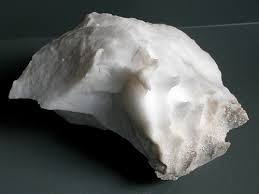alabaster
英 [ˌæl.əˈbæs.tər]
美 [ˈæl.ə.bæs.tɚ]
- adj. 雪花石膏制的;光洁雪白的
- n. 雪花石膏
- n. (Alabaster)人名;(英)阿拉巴斯特

记忆方法
将“alabaster”联想为一个“阿拉巴斯坦人”(Alabaster Man),想象这个人物拥有洁白如石灰的皮肤,像大理石一样光滑。这种形象化记忆可以帮助记住单词“alabaster”,它指的是一种类似大理石的白色石膏。
以上内容由AI生成, 仅供参考和借鉴
中文词源
alabaster 雪花石膏
可能来自埃及语。
英语词源
- alabaster
-
alabaster: [14] Chaucer was the first English author to use the word alabaster: in the Knight’s Tale (1386) he writes of ‘alabaster white and red coral’. It comes, via Old French and Latin, from Greek alábast(r)os, which may be of Egyptian origin. Scottish English used the variant from alabast until the 16th century (indeed, this may predate alabaster by a few years); and from the 16th to the 17th century the word was usually spelled alablaster, apparently owing to confusion with arblaster ‘crossbowman’.
The use of alabaster for making marbles (of the sort used in children’s games) gave rise to the abbreviation alley, ally ‘marble’ in the early 18th century.
- alabaster (n.)
- translucent whitish kind of gypsum used for vases, ornaments, and busts, late 14c., from Old French alabastre (12c., Modern French albâtre), from Latin alabaster "colored rock used to make boxes and vessels for unguents," from Greek alabastros (earlier albatos) "vase for perfumes," perhaps from Egyptian 'a-labaste "vessel of the goddess Bast." Used figuratively for whiteness and smoothness from 1570s. "The spelling in 16-17th c. is almost always alablaster ..." [OED].
权威例句
- 1. She wore a fine chain about her alabaster neck.
- 她细腻光滑、美丽白皙的脖子上戴着一条精致的链子。
- 2. The floor was marble tile, and the columns alabaster.
- 地板是由大理石铺成的, 柱子则是雪花石膏打造而成.
- 3. The trees, the bushes and the tall ferns are carved with alabaster.
- 无论乔木 、 灌木还是蕨草,都似玉砌冰雕.
- 4. Rosette gives the impression of alabaster wax suffused with violet.
- 叶瓣有一种弥漫着紫罗兰色的哑光石蜡的质感.
- 5. Her skin was like alabaster.
- 她的皮肤光洁雪白.
